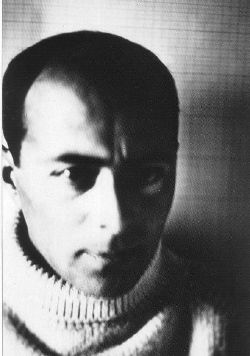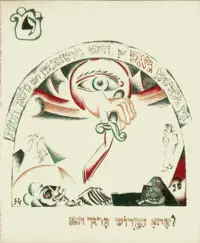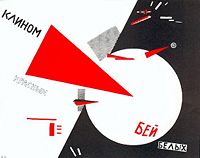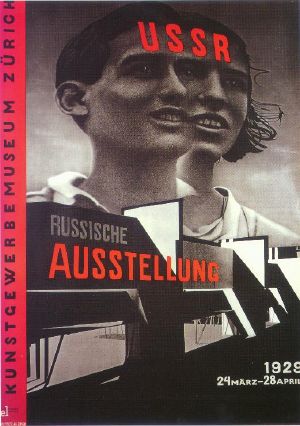El Lissitzky
| El Lissitzky |
|---|
El Lissitzky in a 1924 self-portrait
|
| Born |
| November 23, 1890 Pochinok |
| Died |
| December 30, 1941 Moscow |
Lazar Markovich Lissitzky ⶠ(ĞĞ°Ğ·Ğ°ÑÑ ĞĞ°ÑĞºĞ¾Ğ²Ğ¸Ñ ĞиÑиÑкий, November 23, 1890 â December 30, 1941), better known as El Lissitzky (ĞĞ»Ñ ĞиÑиÑкий), was a Russian artist, designer, photographer, teacher, typographer, and architect. He was one of the most important figures of the Russian avant garde, helping develop suprematism with his friend and mentor, Kazimir Malevich, designing numerous exhibition displays and propaganda works for the former Soviet Union. His work greatly influenced the Bauhaus, Constructivist, and De Stijl movements and experimented with production techniques and stylistic devices that would go on to dominate twentieth century graphic design.
Lissitzky's entire career was laced with the belief that the artist could be an agent for change, later summarized with his edict, "das zielbewuÃte Schaffen" (The goal-oriented creation).[1] A Jew, he began his career illustrating Yiddish children's books in an effort to promote Jewish culture in Russia, a country that was undergoing massive change at the time and had just repealed its anti-semitic laws. Starting at the age of 15, he began teaching; a duty he would stay with for the vast majority of his life. Over the years, he taught in a variety of positions, schools, and artistic mediums, spreading and exchanging ideas at a rapid pace. He took this ethic with him when he worked with Malevich in heading the suprematist art group, UNOVIS, when he developed a variant suprematist series of his own, Proun, and further still in 1921, when he took up a job as the Russian cultural ambassador in Weimar Germany, working with and influencing important figures of the Bauhaus and De Stijl movements during his stay. In his remaining years he brought significant innovation and change to the fields of typography, exhibition design, photomontage, and book design, producing critically respected works and winning international acclaim for his exhibition design. This continued until his deathbed, when in 1941 he produced one of his last known works â a Soviet propaganda poster rallying the people to construct more tanks for the fight against Nazi Germany.
Early years
Lissitzky was born on November 23, 1890 in Pochinok, a small Jewish community 50 kilometers southeast of Smolensk. During his childhood, he lived and studied in the city of Vitebsk, now part of Belarus, and later spent 10 years in Smolensk living with his grandparents and attending the Smolensk Grammar School. Always expressing an interest and talent in drawing, he started to receive instruction at the age of 13 from Jehuda Pen, a local Jewish artist, and by the time he was 15 began teaching students himself. In 1909, he applied to an art academy in Petersburg, but was rejected. While he passed the entrance exam and was qualified, the law under the Tsarist regime only allowed a limited number of Jewish students to attend Russian schools and universities.
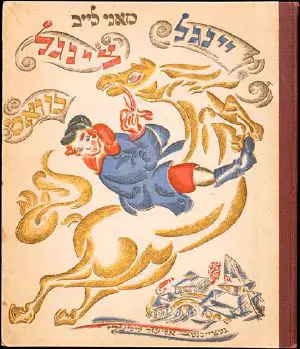
Like many other Jews living in the Russian Empire at the time, Lissitzky went to Germany, to study architecture and engineering at a Darmstadt University of Technology (Technische Hochschule in Darmstadt). During the summer of 1912, Lissitzky, in his own words, "wandered through Europe", spending time in Paris, covering 1200 km on foot in Italy, teaching himself about fine art and sketching architecture and landscapes that interested him.[3] In the same year, some of his pieces were included for the first time in an exhibit by the Saint Petersburg Artists Union; a notable first step for Lissitzky. He remained in Germany until the outbreak of World War I, when he was forced to return home along with many of his countrymen, including other expatriate artists born in the former Russian Empire, such as Wassily Kandinsky and Marc Chagall.
After the war, he went to Moscow and attended the Polytechnic Institute of Riga, which had been evacuated to Moscow because of the war. He received an architectural diploma from the school and immediately started assistant work at various architectural firms. During this work, he took an active and passionate interest in Jewish culture which, after the downfall of the openly anti-semitic Tsarist regime, was flourishing and experiencing a renaissance at the time. The new Provisional Government repealed a decree that prohibited the printing of Hebrew letters and that barred Jews from citizenship. Thus Lissitzky soon devoted himself to Jewish art, exhibiting works by local Jewish artists, traveling to Mahilyow to study the traditional architecture and ornaments of old synagogues, and illustrating many Yiddish children's books. These books were Lissitzky's first major foray in book design, a field that he would greatly innovate during his career.
His first designs appeared in the 1917 book Sihas hulin: Eyne fun di geshikhten (An Everyday Conversation), where he incorporated Hebrew letters with a distinctly Art nouveau flair. His next book was a visual retelling of the traditional Jewish Passover song Had gadya (One Goat), in which Lissitzky showcased a typographic device that he would often return to in later designs. In the book, Lissitzky integrated letters with images through a system of color coding that matched the color of the characters in the story with the word referring to them. In the designs for the final page (pictured right), Lissitzky depicts the mighty "hand of God" slaying the angel of death, who wears the tsar's crown. This representation links the redemption of the Jews with the victory of the Bolsheviks in the Russian Revolution.[2] Visual representations of the hand of God would recur in numerous pieces throughout his entire career, most notably with his 1925 photomontage self-portrait The Constructor, which prominently featured the hand.
Avant garde
Suprematism
In 1919, Lissitzky received an invitation from fellow Jewish artist Marc Chagall, returning to Vitebsk to teach graphic arts, printing, and architecture at the newly formed People's Art School â a school that Chagall created after being appointed Commissioner of Artistic Affairs for Vitebsk in 1918. Chagall also invited other Russian artists, most notably the painter and art theoretician Kazimir Malevich and Lissitzky's former teacher, Jehuda Pen. Malevich would bring with him a wealth of new ideas, most of which both clashed with Chagall and greatly inspired Lissitzky. After going through impressionism, primitivism, and cubism, Malevich started developing and aggressively advocating his ideas on suprematism. In development since 1915, suprematism rejected the imitation of natural shapes and focused more on the creation of distinct, geometric forms. He replaced the classic teaching program with his own, disseminating his suprematist theories and techniques school-wide. Chagall advocated more classical ideals and Lissitzky, still loyal to Chagall, became torn between two opposing artistic paths. Lissitzky ultimately favored Malevich's suprematism and broke away from traditional Jewish art. Chagall left the school shortly thereafter.
At this point Lissitzky subscribed fully to suprematism and, under the guidance of Malevich, helped further develop the movement. Some of his most famous works derive from this era, with perhaps his most famous being the 1919 propaganda poster "Beat the Whites with the Red wedge" (pictured right). Russia was going through a civil war at the time, which was mainly fought between the "Reds", who were the communists and revolutionaries, and the "Whites" who were the monarchists, conservatives, liberals and socialists who opposed the Bolshevik Revolution. The imagery of the red wedge shattering the white form, simple as it was, communicated a powerful message that left no doubt in the viewers mind of its intention. The piece is often seen as alluding to the similar shapes used on military maps and, along with its political symbolism, was one of Lissitzky's first major steps away from Malevich's non-objective suprematism into a style his own. He stated:
The artist constructs a new symbol with his brush. This symbol is not a recognizable form of anything that is already finished, already made, or already existent in the world â it is a symbol of a new world, which is being built upon and which exists by the way of the people.[4]
Also in 1919, Lissitzky joined and took a prominent role in the short-lived but influential UNOVIS group (Russian abbreviation for "The Champions of the New"), a proto-suprematist association of students, professors, and other artists. Formerly known as MOLPOSNOVIS and POSNOVIS, the group was re-branded as UNOVIS when Malevich became leader. In February of 1920, under the leadership of Malevich, the group worked on a "suprematist ballet", choreographed by Nina Kogan, and the precursor to Aleksander Kruchenykh's influential futurist opera, Victory Over the Sun. Interestingly, Lissitzky and the entire group chose to share credit and responsibility for the works produced within the group, signing most pieces with a single, solitary black square. This was partly an homage to a similar piece by their leader, Malevich, and a symbolic embrace of the Communist ideal. This would become the de facto seal of UNOVIS that took the place of individual names or initials. The group, which disbanded in 1922, would play a pivotal role in the dissemination of suprematist ideology in Russia and abroad as well and launch Lissitzky's status as one of the leading figures in the avant garde.
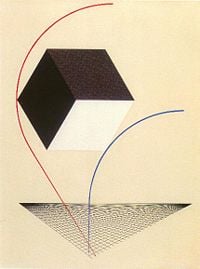
Proun
During this period Lissitzky proceeded to develop a variant suprematist style of his own, a series of abstract, geometric paintings which he called Proun (pronounced "pro-oon"). Proun was essentially Lissitzky's exploration of the visual language of suprematism with spatial elements, utilizing shifting axes and multiple perspectives; both uncommon ideas in suprematism. Suprematism at the time was conducted almost exclusively in flat, 2-dimensional forms and shapes, and Lissitzky, with a taste for architecture and other 3-dimensional concepts, tried to expand suprematism beyond this. His Proun works (known as Prounen), spanned over a half a decade and evolved from straightforward paintings and lithographs into fully 3-dimensional installations. They would also lay the foundation for his later experimentations in architecture and exhibition design. While the paintings were artistic in their own right, their use as a staging ground for his early architectonic ideas was significant. In these works, the basic elements of architecture â volume, mass, color, space and rhythm â were subjected to a fresh formulation in relation to the new suprematist ideals.
Jewish themes and symbols also sometimes made appearances in his Prounen, usually with Lissitzky using Hebrew letters as part of the typography or visual code. For the cover of the 1922 book Teyashim (Four Billy Goats) (JPG), he shows an arrangement of Hebrew letters as architectural elements in a dynamic design that mirrors his contemporary Proun typography.[2] This theme was extended into other works, namely his illustration for the books "Shifs-Karta" (Passenger Ticket) and "Shifs-Karta." The exact meaning of the word Proun was never fully revealed, with some suggesting that it is a contraction of "proekt unovsia" ("Architectural design of UNOVIS"), or "proekt utverzhdenya novoga" ("Design for the confirmation of the new"). It was later defined by Lissitzky ambiguously as "the station where one changes from painting to architecture."[3]
Return to Germany
In 1921, roughly concurrent with the demise of UNOVIS, suprematism was beginning to fracture into two ideologically adverse halves, one favoring Utopian, spiritual art and the other favoring a more utilitarian art that serves society. Lissitzky was fully part of neither and left Vitebsk in 1921. He took a job as a cultural representative of Russia, moving to Berlin where he was to establish contacts between Russian and German artists. There he also took up work as a writer and designer for international magazines and journals while helping to promote the avant garde through various gallery shows. He started the very short-lived, but impressive, periodical Veshch-Gerenstand Objekt with Russian-Jewish writer Ilya Erenburg. The periodical was intended to show off contemporary Russian art to Western Europe, mainly focusing on new suprematist and constructivist works, and was published in German, French, and Russian languages. In the first issue, Lissitzky wrote:
We consider the triumph of the constructive method to be essential for our present. We find it not only in the new economy and in the development of the industry, but also in the psychology of our contemporaries of art. Veshch will champion constructive art, whose mission is not, after all, to embellish life, but to organize it.[1]
During his stay he also developed his career as a graphic designer with some historically important works such as the book Dlia Golossa (For the Voice), a collection of poems from Vladimir Mayakovsky, and the book "Die Kunstismen" (The Artisms) together with Jean Arp. There he also met and befriended many other artists, most notably Kurt Schwitters, László Moholy-Nagy, and Theo van Doesburg. Lissitzky, together with Schwitters and van Doesburg, presented the idea of an international artistic movement under the guidelines of Constructivism while also working with Kurt Schwitters on the issue Nasci (Nature) of the periodical Merz (pictured right), and continuing to illustrate children's books. After the publication of his first Proun series in Moscow in 1921, Schwitters introduced Lissitzky to the Hanover gallery Kestner-Gesellschaft in 1922, where he held his first solo exhibition. The second Proun series, printed in Hanover in 1923, was a success, utilizing new and sophisticated printing techniques. Later on, he met Sophie Kuppers, the widow of an art director at a gallery where Lissitzky was showing, whom he would marry in 1927.
Later years
In 1924 Lissitzky went to Switzerland to receive treatment for his tuberculosis. He kept very busy during his stay, working on advertisements designs for Pelikan Industries (who in turn paid for his treatment), translating articles written by Malevich into German, and experimenting heavily in typographic design and photography. In 1925, after the Swiss government denied his request to renew his visa, Lissitzky returned to Moscow and began teaching interior design, metalwork, and architecture at VKhUTEMAS (State Higher Artistic and Technical Workshops), a post he would keep until 1930.
While there, he all but stopped his Proun works and became increasingly active in architecture and propaganda designs. In 1926, he and architect Emil Roth designed the Wolkenbügel (Cloud-iron), a unique skyscraper on 3 posts planned for Moscow. Although never built, the building was a vivid contradiction to America's vertical building style, as the building only rose up a relatively modest height then expanded horizontally over an intersection so make better use of space. Its three posts were on three different street corners, canvassing the intersection. An illustration of it appeared on the front cover of Adolf Behne's book, Der Moderne Zweckbau, and articles on it written by Lissitzky appeared in an issue of the Moscow-based architectural review, ASNOVA (The Association of New Architects), and in the German art journal Das Kunstblatt.
In addition to his work in architecture, he also began designing numerous exhibition displays for the government including the Internationale Kunstausstellung in Dresden, and the Raum Konstruktive Kunst (Room for Constructivist art) and Abstraktes Kabinett in Hanover, along with many Soviet pavilions, including one of their pavilions at the 1939 World Fair in New York. One of his most notable exhibits was the Polygraphic Exhibit in Moscow in 1927, which won him a state appointment as head of the team of artists who would design the coming pavilions. His work on the exhibit was radically new, especially juxtaposed to the very classical designs of other participating countries.
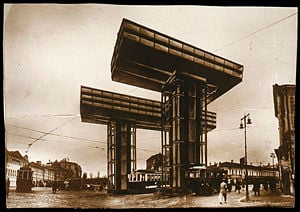
Along with pavilion design, Lissitzky began experimenting with print media again. His work with book and periodical design was perhaps some of his most accomplished and influential. He launched new and radical innovations in typography and photomontage, two fields in which he was particularly adept. He even designed a photomontage birth announcement in 1930 for his recently born son, Jen. The image itself is seen as being another personal endorsement of the Soviet Union, as it superimposed an image of the infant Jen over a factory chimney, linking Jen's future with his country's industrial progress. Around this time, Lissitzky's interest in book design escalated. In his remaining years, some of his most challenging and innovative works in this field would develop. In discussing his vision of the book, he wrote:
In contrast to the old monumental art [the book] itself goes to the people, and does not stand like a cathedral in one place waiting for someone to approachâ¦. [The book is the] monument of the future.[1]
He perceived books as permanent objects that were invested with power. This power was unique in that it could transmit ideas to people of different times, cultures, and interests, and do so in ways other art forms could not. This represented a thread of ambition that laced all of his work, particularly in his later years. Lissitzky was devoted to the idea of creating art with power and purpose; art that could invoke change.
A significant portion of his work during this period was Soviet propaganda. He started working for the propaganda magazine USSR im Bau (USSR in construction), where some of his most wild experiments with book design were produced. Each issue focused on a particular topic of importance to Stalin at the time â a new dam being built, constitutional reforms, Red Army progress and so on. In 1941 he became ill again with tuberculosis, but still continued to produce works, like the propaganda poster for Russia's efforts in World War II, entitled "Davaite pobolshe tankov!" (Give us more tanks!) He died on December 30, 1941, in Moscow.
Legacy
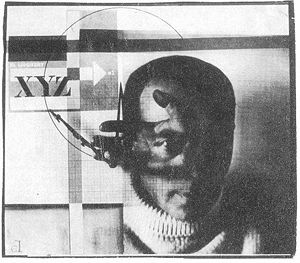
Throughout his career, Lissitzky advanced a number of methods, ideas, and movements that had a large and significant impact on contemporary art â particularly in the fields of graphic design, exhibition design, and architecture. Partly because of his constant expansion and experimentation into many different mediums and styles, and his spirit of innovation in them, Lissitzky's work is generally held in high regard by historians and critics. He was one of the principal innovators of modern typography and photomontage, both relatively nascent fields at the time.
He was also preoccupied from early to late career with book design. He thought of the book as a dynamic object, a "unity of acoustics and optics" requiring the viewer's active involvement. When working on USSR im bau he took his experimentation and innovation with book design to an extreme. In issue #2 he included multiple fold-out pages, presented in concert with other folded pages that together produced design combinations and a narrative structure that was completely original at the time. He also invested great effort into establishing international links between artists and promoting new ideas, helping the avant-garde spread across Europe. This started locally with UNOVIS, where he attempted to spread and promote new art primarily in Russia, and reached its peak with his stay in Germany, where he exchanged ideas internationally and helped influence the German Bauhaus and Dutch De Stijl movements.
Along with his efforts towards the advancement of art, Lissitzky worked tirelessly for ways to better life with art. For that purpose he chose to study architecture in his youth; an artistic medium that directly affects and contributes to society. He was an ardent supporter of the Communist ideology and devoted a great part of his life and energy in its service. Through his Prouns, Utopian models for a new and better world were developed. This approach, in which the artist creates art with socially defined purpose, could aptly be summarized with his edict "das zielbewuÃte Schaffen" â "the task-oriented creation."[1]
In his later years he brought revolutionary change to exhibition design, garnering him respect internationally as well as prestige within his own country and government. In exhibition and propaganda design, he found an area where he could apply his creative forces in the service of society. In his autobiography written in June 1941 (which was later edited and released by his wife), Lissitzky wrote, "1926. My most important work as an artist begins: the creation of exhibitions."[3]
Selected works
| Selected works | |||
|---|---|---|---|
| Type | Year | Description | Media |
| Yiddish works | 1917 | Sihas hulin: Eyne fun di geshikhten (An everyday conversation: A story) | Cover |
| 1919 | "Cover of Yingl Tzingl Khvat" (The Mischievous Boy) | Cover | |
| Had gadya (One goat) | Cover Page Page Last page | ||
| 1922 | Teyashim (Four billy goats) | Cover | |
| Paintings, Posters | 1919 | Lithograph, Beat the white with the Red wedge | Image |
| 1929 | Poster for the Russian Exhibition, Kunstgewerbemuseum, Zurich | PosterStudy for poster | |
| Proun | 1920 | Proun 2C | Proun |
| 1922 | Untitled Proun | Proun | |
| Proun children's book Suprematicheskii skaz pro dva kvadrata v shesti postroikakh (Suprematist story of two squares in six constructions) | Cover Page 1 Page 2 Page 3 Page 4 Page 5 Page 6 Page 7 Page 8 Page 9 Page 10 End page Back cover | ||
| 1923 | Proun 12E | Proun | |
| 1924 | Untitled Proun | Proun | |
| c.1925 | Proun 99 | Proun | |
| Untitled Proun | Proun | ||
| Graphic design | 1922 | Shest povestei o legkikh kontsakh (Six stories about light endings), book by Ilya Ehrenburg | Cover |
| 1923 | Layout for Vladimir Mayakovsky, Dlia golosa (For the Voice) | Cover Page 1 Page 2 Page 3-4 Page 5-6 Page 7-8 Page 9-10 Page 11-12 Page 13 Page 14 Page 15-16 Page 17-18 Page 21-22 Page 23-24 | |
| Page from program for Victory over the Sun | Design | ||
| 1924 | Merz Layout. Vol 2, No. 8/9, "Nasci," | Front coverBack cover | |
| 1925 | Die Kunstismen (The Artisms) by Lissitzky and Hans Arp | Cover Pages | |
| 1928 | Exhibition guidebook of Union der Sozialistischen Sowjet-Republiken: Katalog des Sowjet-Pavillons auf der Internationalen Presse-Ausstellung(Union of Soviet Socialist Republics: Catalog of the Soviet Pavilion at the International Press Exhibition, Cologne) | Cover | |
| 1930 | Russland: Die Rekonstruktion der Architektur in der Sowjetunion (Russia: The reconstruction of architecture in the Soviet Union) | Front cover Back cover | |
| 1935 | Industriia sotsializma: Tiazhelaia promyshlennost k VII Vsesoiuznomu Sezdu Sovetov (Industry of socialism: Heavy industry for the Seventh Congress of Soviets) | Cover | |
| Advertisement design | 1924 | Advertisement for Pelican Drawing Ink | Design |
| Wood-panel advertising relief for Pelikan typewriter ribbons | Design | ||
| 1925 | Advertisement for Pelican Drawing Ink | Design | |
| Photography | 1925 | Self-portraits | 19241925 |
| Photomontage of Kurt Schwitters | Image | ||
| 1928 | Runner in the City | Image | |
| 1929 | Exhibition catalog for Iaponskoe kino: Vystavka (Japanese cinema exhibition) | Cover | |
| 1930 | Montage of workers and smokestacks, for USSR im bau | Image | |
| Architecture | 1925 | Photomontage of The Wolkenbügel | Image |
| 3D computer rendering of The Wolkenbügel | MPEG-1 - 13.25 M | ||
| Aerial drawing of The Wolkenbügel | Drawing | ||
| 1928 | Design for a flag stand, Soviet Pavilion, International Press Exhibition | Drawing | |
| 1930 | Model for the House of Heavy Industry | Image | |
| Exhibitions | 1926 | Photograph of section of Raum Konstruktive Kunst (Room for Constructivist art), International Art Exhibition, Dresden | Image |
| c.1927 | Design for the Abstraktes Kabinett (Abstract Cabinet) | Design | |
| 1928 | Photo of Soviet Pavilion, International Press Exhibition | Image | |
| Photo of "The Iron Man,"Soviet Pavilion, International Press Exhibition | Image | ||
| Photo of display of Soviet newspapers, Soviet Pavilion, International Press Exhibition | Image | ||
| 1929 | Design of the Soviet Room, International Film and Photo Exhibition, Stuttgart | Sketch1 Sketch 2 | |
| Personal Letters | 1924 | Letter to Sophie Küppers regarding Die Kunstismen | Letter |
| 1925 | Letter to Sophie Küppers regarding the Reklamrelief (Pelikan relief) | Letter | |
| 1935 | Letter to Sophie Küppers regarding stay in Switzerland | Letter | |
| Source: Works by El Lissitzky (2001). [4] Retrieved March 20, 2005. â Source: Monuments of the Future: Designs by El Lissitzky (2002)[5] Retrieved March 20, 2005 â Source: El Lissitzky (2002)[6] Retrieved March 28, 2005 | |||
Large amounts of his work are on permanent display in galleries worldwide. Much of his collection of Proun works can be viewed in the Van Abbemuseum in the Netherlands, with other abstract works on display in Sprengel Museum in Hannover. His work is also part of the Peggy Guggenheim Collection in Venice.
Notes
- â 1.0 1.1 1.2 1.3 Anna Glazova. El Lissitzky in Weimar Germany. [1]. accessdate March 8, 2005
- â 2.0 2.1 2.2 2.3 2.4 Monuments of the Future. Getty Institute - Monuments to the Future: Designs by El Lissitzky. [2]. accessdate March 20, 2005
- â 3.0 3.1 3.2 Sophie Lissitzky-Kuppers. El Lissitzky, life, letters, texts. (Thames and Hudson, 1980. ISBN 0500230900)
- â formDefined: one by one by one. [3] accessdate March 9, 2005
ReferencesISBN links support NWE through referral fees
- Lissitzky-Kuppers, Sophie. El Lissitzky, life, letters, texts. Thames and Hudson, 1992 (original 1980). ISBN 0500230900
- Mayakovsky, Vladimir and El Lissitzky. For the Voice (Dlia golosa). The MIT Press, 2000. ISBN 0262133776
- Perloff, Nancy, and Brian Reed. Situating El Lissitzky: Vitebsk, Berlin, Moscow. Getty Research Institute, 2003. ISBN 089236677X
- Stedelijk Van Abbemuseum and El Lissitzky. El Lissitzky, 1890â1941: Architect Painter Photographer Typographer. Municipal Van Abbemuseum, 1990. ISBN 9070149281.
External links
All links retrieved February 12, 2024.
- Anna Glazova. El Lissitzky in Weimar Germany - An essay and biography on his life and work, focusing particularly on his time in Germany
- Ibiblio.org - Image collection of some of his most famous works
Credits
New World Encyclopedia writers and editors rewrote and completed the Wikipedia article in accordance with New World Encyclopedia standards. This article abides by terms of the Creative Commons CC-by-sa 3.0 License (CC-by-sa), which may be used and disseminated with proper attribution. Credit is due under the terms of this license that can reference both the New World Encyclopedia contributors and the selfless volunteer contributors of the Wikimedia Foundation. To cite this article click here for a list of acceptable citing formats.The history of earlier contributions by wikipedians is accessible to researchers here:
The history of this article since it was imported to New World Encyclopedia:
Note: Some restrictions may apply to use of individual images which are separately licensed.
